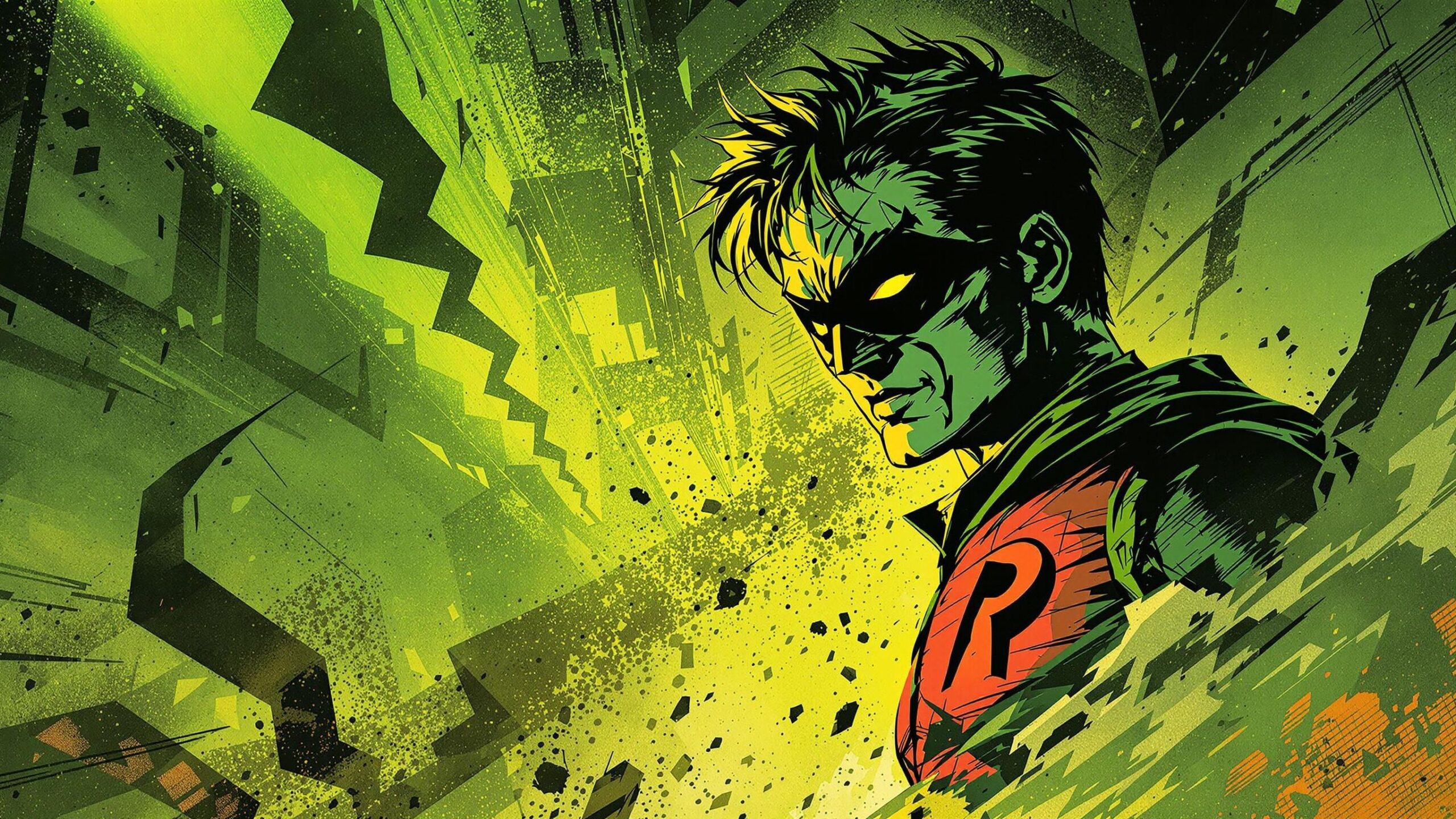From Circus Acrobat to Gotham’s Brightest Hope
When you think of Batman, you probably picture a brooding figure perched on a rooftop, cape fluttering in the night, ready to pounce on Gotham’s criminal underbelly. But lurking just behind that shadowy figure is someone a little more colorful, a little more acrobatic, and—dare we say—a little more fun. Robin. The Boy Wonder. The partner in crimefighting. The loyal sidekick who’s been flipping through Gotham’s skyline for over eight decades. While Batman brings the darkness, Robin brings the light. He’s the yin to Bruce Wayne’s yang, the quip to his growl, the punch of color in a world of grey. But Robin isn’t just a single character—he’s a legacy. A mantle passed through time, each version reflecting the era it was born in and bringing something fresh to the cape and domino mask. From Dick Grayson to Damian Wayne, Robin has evolved, endured, and remained one of the most beloved sidekicks in comic book history.
Dick Grayson: The First and the Fiercest
The original Robin, Dick Grayson, made his debut in Detective Comics #38 in 1940. A former circus acrobat orphaned by a mob hit, Dick was taken in by Bruce Wayne and trained to become the first Robin. What followed was a seismic shift in the Batman mythos. For the first time, the Dark Knight wasn’t alone. Robin brought a new energy to the stories—witty banter, athletic prowess, and a whole lot of heart. He was the kid readers could relate to, a bright spark beside a brooding detective.
Over time, Dick’s character grew beyond the sidekick role. He matured, took on greater responsibilities, and eventually adopted the identity of Nightwing. That transition was significant—it was the first time a sidekick truly “graduated” and carved out a legacy of his own. As Nightwing, Dick became a leader, an icon, and a symbol of hope in cities like Blüdhaven. But no matter how far he flew from the Batcave, he was always the original Robin—the prototype, the gold standard, the one who turned sidekicks into stars.
Jason Todd: The Tragic Rebel
After Dick’s departure, the Robin mantle passed to Jason Todd—a streetwise kid with a chip on his shoulder and a penchant for breaking rules. Introduced in 1983, Jason was a stark contrast to his predecessor. He was fiery, impulsive, and far more prone to anger. While some fans struggled to embrace the new Robin, Jason’s complexity brought new tension to the Bat-family dynamic. He challenged Batman in ways Dick never did, forcing Bruce to confront his own rigid moral code.
Jason’s story took a shocking turn in 1988’s A Death in the Family arc, where readers were infamously given the choice—via a telephone poll—to decide his fate. The result? Jason was killed by the Joker in a brutal and unforgettable moment that shook the comic book world. But death wasn’t the end. Jason returned years later as the Red Hood, a vigilante with a more lethal approach to justice. His resurrection gave Robin’s legacy a darker edge and showed that even sidekicks could fall—and rise again with vengeance in their eyes.
Tim Drake: The Detective Protégé
In the wake of Jason’s death, the Robin identity was retired—temporarily. But then came Tim Drake, the fanboy-turned-sleuth who earned his spot not by acrobatics or tragedy, but through pure intellect. Tim figured out Batman and Nightwing’s identities all on his own, proving that he was not just observant—he was brilliant. He wasn’t looking to be a hero for the sake of glory. He believed Batman needed a Robin to keep him grounded, to keep him human. And so, with careful training and unwavering determination, Tim became the third official Robin.
Tim brought a more measured, cerebral energy to the role. He was a strategist, a tech wizard, and an all-around super-sleuth. Over time, he led his own version of the Teen Titans, became Red Robin, and proved that brains could be just as heroic as brawn. Tim’s version of Robin felt like a love letter to fans—the kid who read the comics and dreamed of joining the Bat-family, only to discover he had what it took all along. He made being Robin look like something that could be earned, not just inherited.
Stephanie Brown: The Brief but Bold Robin
In the rich history of Robins, Stephanie Brown holds a unique place. Originally appearing as the Spoiler—a vigilante determined to disrupt her villainous father’s schemes—Stephanie eventually became the first official female Robin. Her tenure was brief, controversial, and tragically cut short. But make no mistake—Stephanie left a lasting mark.
Her time as Robin was groundbreaking. It challenged the “boys’ club” dynamic of the Batcave and gave young female readers a chance to see themselves in the role. Stephanie was brave, stubborn, and eager to prove herself. Though Batman often questioned her readiness, Stephanie’s passion for justice and refusal to back down made her unforgettable. Her tragic “death” and eventual return as Batgirl only added to her mythos. Stephanie Brown showed that the Robin mantle wasn’t defined by gender or lineage—it was defined by spirit.
Damian Wayne: The Heir with a Sword
Enter Damian Wayne—the biological son of Bruce Wayne and Talia al Ghul, raised by the League of Assassins and introduced with a scowl and a sword. Damian is the wild card of the Robin lineup, a ten-year-old assassin with lethal skills, a superiority complex, and a desperate need for approval. When Bruce finally brings him under his wing, the results are explosive, heartfelt, and endlessly entertaining.
Damian is a walking contradiction. He’s a killer trying to be a hero, a child trained in death learning how to value life. His relationship with his father is fraught with tension, pride, and slow-earned trust. And while he starts out prickly and arrogant, Damian’s journey is one of the most rewarding in modern comics. His bond with Dick Grayson during their time as Batman and Robin is a masterclass in character contrast and chemistry. Damian is the Robin who had the most to unlearn—and the most to gain from finding his place in a family that didn’t see him as a weapon, but as a person.
The Costume That Changed Comics
Let’s take a moment to appreciate the costume—the red, green, and yellow ensemble that made Robin instantly recognizable on every comic shelf. Designed to be a counterbalance to Batman’s brooding black and grey, the costume was meant to draw attention, to distract criminals from the real threat in the shadows. Over the years, the outfit has evolved—becoming sleeker, more armored, less circus-like—but it has always carried the same energy: hope, youth, and defiance in the face of danger. That cape may be smaller than Batman’s, but its legacy is just as mighty.
Robin in Animation and Beyond
Robin’s impact isn’t confined to comics. From Batman: The Animated Series to Teen Titans and Young Justice, the various incarnations of Robin have dazzled across screens big and small. Each show puts its own spin on the character, highlighting different traits—Dick’s leadership, Tim’s cleverness, Damian’s fire, and even Jason’s rage. The Teen Titans animated series, in particular, turned Robin into a household name for a whole new generation, blending angst with absurdity and giving fans a Robin who was a leader, not just a sidekick.
In live-action, Robins have popped up here and there—from Chris O’Donnell’s leather-clad portrayal in the ’90s films to Joseph Gordon-Levitt’s subtle nod in The Dark Knight Rises. While Robin hasn’t had a full live-action spotlight in recent big-screen Bat-films, fans are still clamoring for his return. The character’s legacy is too rich, too resonant, and too beloved to remain sidelined for long.
Robin as a Symbol
At the end of the day, Robin isn’t just a sidekick. He’s a symbol. He represents resilience, growth, and the idea that even in the darkest of cities, there’s always a spark of hope. Robin is the kid who stands up to evil not because he has to, but because he chooses to. He’s the laughter that cuts through Batman’s silence. The light that balances the shadow. The reminder that justice isn’t just about punishment—it’s about partnership, mentorship, and legacy.
Each Robin brings something unique to the table. Dick Grayson is the heart. Jason Todd is the fire. Tim Drake is the brain. Stephanie Brown is the soul. Damian Wayne is the will. Together, they form a lineage of heroes that prove sidekicks aren’t lesser—they’re essential. Without Robin, Batman is just a man consumed by vengeance. With Robin, he’s part of something bigger. A family. A mission. A myth.
The Legacy That Soars
Robin isn’t just a cape and a catchphrase. He’s a character who has grown, faltered, evolved, and inspired across generations. From the Golden Age of comics to the gritty reboots of today, Robin has remained a fixture of heroism—not as a shadow to the Bat, but as a legend in his own right. He’s been a boy wonder, a lost son, a detective, a warrior, a girl who defied expectations, and a kid trying to find his father’s approval.
And through it all, he’s reminded us that being a sidekick doesn’t mean being second-best. It means being brave enough to stand beside greatness—and, eventually, to become great in your own way. Robin may have started as the junior partner, but through the ages, he’s proven himself as the ultimate ally, the ultimate hero, and the ultimate sidekick.




